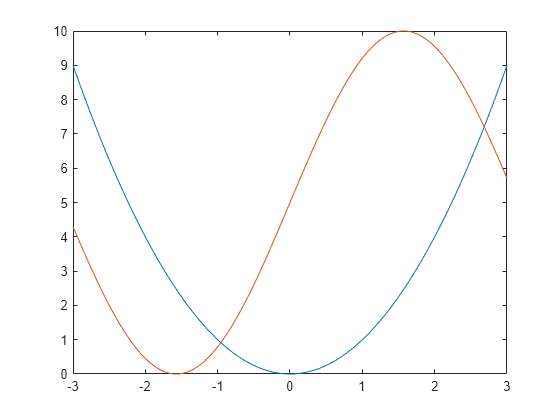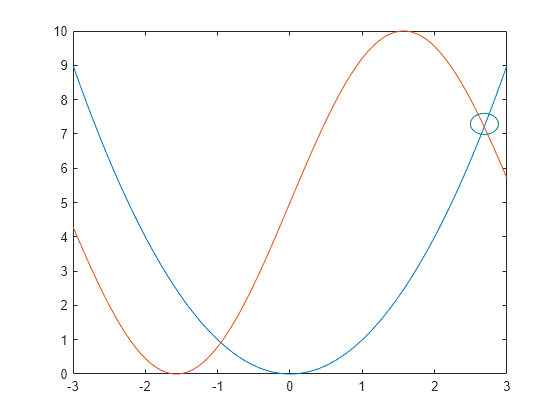Add Annotations to Chart
Annotations are extra information added to a chart to help identify important information. This example first explains the different types of annotations, and then shows you how to add circles and text arrows to a chart.
Types of Annotations
Use the annotation function to add annotations to a chart. The first input to the function specifies the type of annotation you want to create.
If you specify the type as
'line','arrow','doublearrow', or'textarrow', then the second input is the starting and ending x positions of the annotation. The third input is the starting and ending y positions of the annotation. For example,annotation('line',[x_begin x_end],[y_begin y_end]).If you specify the type as
'rectangle','ellipse', or'textbox', then the second argument is the location and size. For example,annotation('rectangle',[x y w h]).
Annotations use normalized figure units and can span multiple axes in a figure.
Create Simple Plot
Define and plot functions f(x) and g(x).
x = -3.0:0.01:3.0; f = x.^2; g = 5*sin(x) + 5; figure plot(x,f) hold on plot(x,g) hold off

Circle Annotations
Add a circle to the chart to highlight where f(x) and g(x) are equal. To create a circle, use the 'ellipse' option for the annotation type.
Customize the circle by setting properties of the underlying object. Return the Ellipse object as an output argument from the annotation function. Then, access properties of the object using dot notation. For example, set the Color property.
elps = annotation('ellipse',[.84 .68 .05 .05])elps =
Ellipse with properties:
Color: [0.1294 0.1294 0.1294]
FaceColor: 'none'
LineStyle: '-'
LineWidth: 0.5000
Position: [0.8400 0.6800 0.0500 0.0500]
Units: 'normalized'
Show all properties
elps.Color = [0 0.5 0.5];

Text Arrow Annotations
Add a text arrow to the chart using the 'textarrow' option for the annotation type.
You can customize the text arrow by setting properties of the underlying object. Return the TextArrow object as an output argument from the annotation function. Then, access properties of the object using dot notation. For example, set the String property to the desired text and the Color property to a color value.
ta = annotation('textarrow', [0.76 0.83], [0.71 0.71])ta =
TextArrow with properties:
String: {''}
FontName: 'Helvetica'
FontSize: 10
Color: [0.1294 0.1294 0.1294]
TextColor: [0.1294 0.1294 0.1294]
LineStyle: '-'
LineWidth: 0.5000
HeadStyle: 'vback2'
Position: [0.7600 0.7100 0.0700 0]
Units: 'normalized'
X: [0.7600 0.8300]
Y: [0.7100 0.7100]
Show all properties
ta.String = 'f(x) = g(x) ';
ta.Color = [0 0.5 0.5]; 